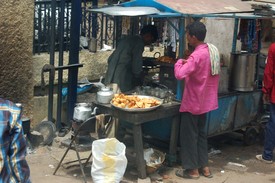
Food prices are soaring around the world. Long lines for rations of rice or wheat flour snake through cities and towns across Asia, Africa, the Caribbean and the Americas. Food protests have rocked Haiti, Egypt, Senegal, Bangladesh and the Philippines. A United Nations report last December listed Haiti and Bangladesh among 37 countries who face “food crises” and need external assistance to stave off mass starvation and famine. The capitalist “free market” economy has helped to create this crisis.
In India, where reportedly one-half of the world’s hungry reside, soaring prices are keeping food out of reach of the poor. The left parties, led by the 600,000-member Communist Party of India (CPI) and the almost 1 million-member Communist Party of India-Marxist (CPI-M), along with parties in the United National Progressive Alliance, are demanding that India’s government take immediate action to guarantee food security for the country. Those parties held mass protests last week, in which leaders were arrested in the capital, Delhi. They vowed to step up the demonstrations if no action was taken to halt the food price inflation, dubbed “agflation,” by April 23.
CPI-M General Secretary Prakash Karat warned that “an explosive situation will emerge if prices are not controlled.” CPI General Secretary A.B. Bardhan demanded that hoarding and financial speculation on food commodities be banned.
Food security was at the top of the two parties’ agendas at their congresses, held at the end of March and early April.
CPI-M leader and member of Parliament Brinda Karat urged her party’s congress to adopt a resolution calling for action on “price rise.”
“India has the largest undernourished population in the whole world,” she said. “Malnourishment has grown among women, children and men.”
She put the blame squarely on government policies that encourage privatization of the public food distribution sector and the growing influence of agribusiness.
Reasons frequently given for the global rise in food prices include soaring costs of oil needed in agriculture production; rising demand from growing economies like China, India and Brazil; and the push by U.S. agricultural corporations for biofuels made from corn and other grains. In many countries, deep agricultural crises — caused by such factors as massive debt burdens on small farmers, war and climate catastrophes — have reduced production. These have indeed been a factor in India’s food inflation, analysts say.
Yet economist C.P. Chandrasekhar puts the main blame elsewhere. Like Brinda Karat, Chandrasekhar argued in a recent column that “the government’s decision to allow private players, including large international firms [such as Cargill], a major role in domestic markets has created a curious situation,” contributing to price increases in commodities like grain, legumes, cooking oil and sugar. Widespread hoarding of food by these corporate entities to keep supply low and demand (and prices) high is a major obstacle to the government providing food for the people.
Financial speculation on agriculture commodities also looms large in both India’s and global agflation. In a recent New York Times column, economist Paul Krugman mentions financial speculation as one of three “theories” about what’s causing the food price spikes. But he dismisses it, and focuses on the other two: heavy demand by China and other rising nations, and the end of “the era of cheap resources” — “we’re running out of oil, running out of land to expand food production and generally running out of planet to exploit,” he says.
While not discounting those factors, progressive economists and the left in India are not so quick to dismiss the massive capital that has poured into speculating on India’s agricultural commodities market. And the spreading financial meltdown in the U.S. is spurring investment capital to increase its pursuit of profit-making “greener pastures” in countries like India.
Chandrasekhar says that, while it is still necessary to “ascertain” the extent to which speculation has contributed to India’s recent food price rises, “fat and rising” profit margins of monopoly corporations, and “retailers and speculation in futures markets are seen by many to be playing a role.”
Chandrasekhar cites The Economist and the UN’s Food and Agricultural Organization as recognizing the marked increase in food speculation. The Economist reported in September 2007, “Trading in agricultural futures, once a backwater, has boomed in recent years. In addition to agribusinesses, more institutional investors — ranging from hedge funds to pension funds — are investing. Last year nearly $3 trillion in grain futures was traded on the Chicago Board of Trade, the world’s largest such market.”
Agricultural futures means “betting” on the future prices of food and capitalists making a profit if they “buy” wheat at $4 a bushel and the price goes up to $9.00 a bushel.
The left and its allies in India are demanding a ban on futures trading in 25 agricultural commodities, strengthening of India’s public food distribution system and stringent action against hoarding.
It’s clear, they say, that the private sector is interested in profit, not feeding the people.
talbano@pww.org









Comments